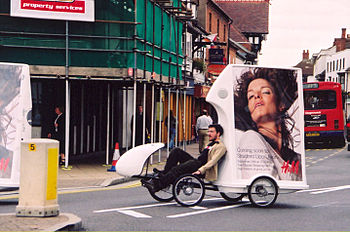- Mobile billboard
-
A mobile billboard is a device within the marketing practice of advertising on the side of a truck or trailer that is typically mobile. Mobile billboards are a form of Out-Of-Home (OOH) Advertising. Radio, static billboards, and mall/airport advertising fall into the same category. Using a mobile billboard for advertising is an advertising niche called mobile outdoor advertising.
Most mobile billboards are dedicated, customized trucks with large, but narrow, bodies for posting the advertisements. Some of these dedicated units offer features such as external sound systems, illumination, and hot/cold boxes for product sampling. This type of mobile billboard is the most popular among vendors, and the most capable in terms of gaining exposure and quick deployment. An innovative development of mobile billboards are dynamic advertising trailers called SkyBoard to hoist large format vinyl banners up to 4000 sq.ft.
Another trend is to use smaller but more distinctive looking mini mobile billboards often based on the Diahatsu Midget from Japan as it is a very rare and unusual looking vehicle in Europe and the USA, these one seater vehicles have a very short wheelbase so they can be parked side on so the large advertising panels on the side are facing the traffic flow, this and the fact that they are such unusual looking vehicles makes them very effective advertising tools.
Some mobile billboards are installed on trucks and trailers that are in service delivering goods. This form of mobile billboards can be less expensive than dedicated trucks, but may also have less impressions because the trucks spend more time at docks loading and unloading their goods.
Box-type trucks with glass panels enclosing the cargo space can be turned into a 3-D display. Many companies use these trucks for parades, product launches, furniture displays, and general rapid awareness creation. Anything can be placed inside of the boxes.
More recently, for micromarketing campaigns, small engine scooters have came into play. The small scooter is used to pull a tall and narrow signage. This form has become a very effective intercity advertising method for Atlanta, Georgia.
Contents
Installation
Advertisements are installed by applying large vinyl sheets as decals or by fastening one large sheet of vinyl to the sides of the truck or trailer using specialized aluminum frames. The advertisements can also be painted directly onto the side of the truck or trailer.
Printing technology
Printing technology has improved to the point where outdoor mobile advertising has become an option that may be less expensive than traditional billboard advertising.[citation needed]
Effectiveness
Industry analysts, researchers and trade representatives have researched the effectiveness of mobile billboards. Outdoor Advertising Magazine said that outdoor mobile media billboards have a 97% recall rate, and 96% of survey respondents thought mobile advertising is more effective than traditional outdoor advertising.[citation needed] 3M and the American Trucking Association noted 91% of the target noticed the text and graphics on truck advertising, and the Traffic Audit Bureau noted that on local routes monthly impressions ranged from one to four millions hits.[citation needed] Product Acceptance and Research said 94% of respondents recalled seeing the Mobile Billboard, with 80% recalling the specific advertisement; the billboards resulted in a sales increase of 107%.[citation needed]
Legality
Some municipalities have strict laws against mobile advertisements. Mobile billboards have been accused of congesting already congested streets, since they seek areas with high populations. In areas such as these, non-motorized but mobile advertisements (i.e. adbikes & Billboard Bicycles) can often be used as a substitute. New emerging companies such as http://www.mobilemedia7.com/ design smaller lighter trucks that can keep up with the stop and go traffic and maneuver through downtown city blocks without causing congestion. These mobile billboard trucks have been welcomed more by municipalities over the larger trucks.
In Norway, the use of wrap advertising on busses was prohibited by the road authorities. The reason behind the ban was that in an emergency, the windows might need to serve as an emergency exit and that the advertising would make the window harder to break with the emergency hammer. Gaia Trafikk argued against the ban, pointing out that their tests showed that the thin wrap had no impact on the breakability of the window, but did remove the advertising which covered the windows.[1] There is now a mobile Billboard truck comp. working in Norway http://mobilebillboards-norway.com/
Other forms
There are many other forms of outdoor mobile advertising, which are considered mobile billboards by some advertising professionals.
One such form is called wrap advertising, which differs from mobile billboards because wrap advertisements typically envelope an entire vehicle, typically a car or small truck, while mobile billboards are large flat surfaces like traditional billboards.
Other mobile advertising formats include bicycles, airplane banner towing, and mobile billboards on water towed by boats.
More recently, companies such as Tripink [1] have developed a new form of mobile billboard called digital or video mobile advertising. The principle is the same as that of traditional mobile billboards except that a digital or video mobile advertising "billboard" is an actual screen, which can display commercials.
See also
References
- ^ Livsfarlig reklame ("Life-threatening advertising") Dagbladet, July 5, 2001, retrieved April 17, 2007
Categories:- Advertising tools
- Public transport
Wikimedia Foundation. 2010.


